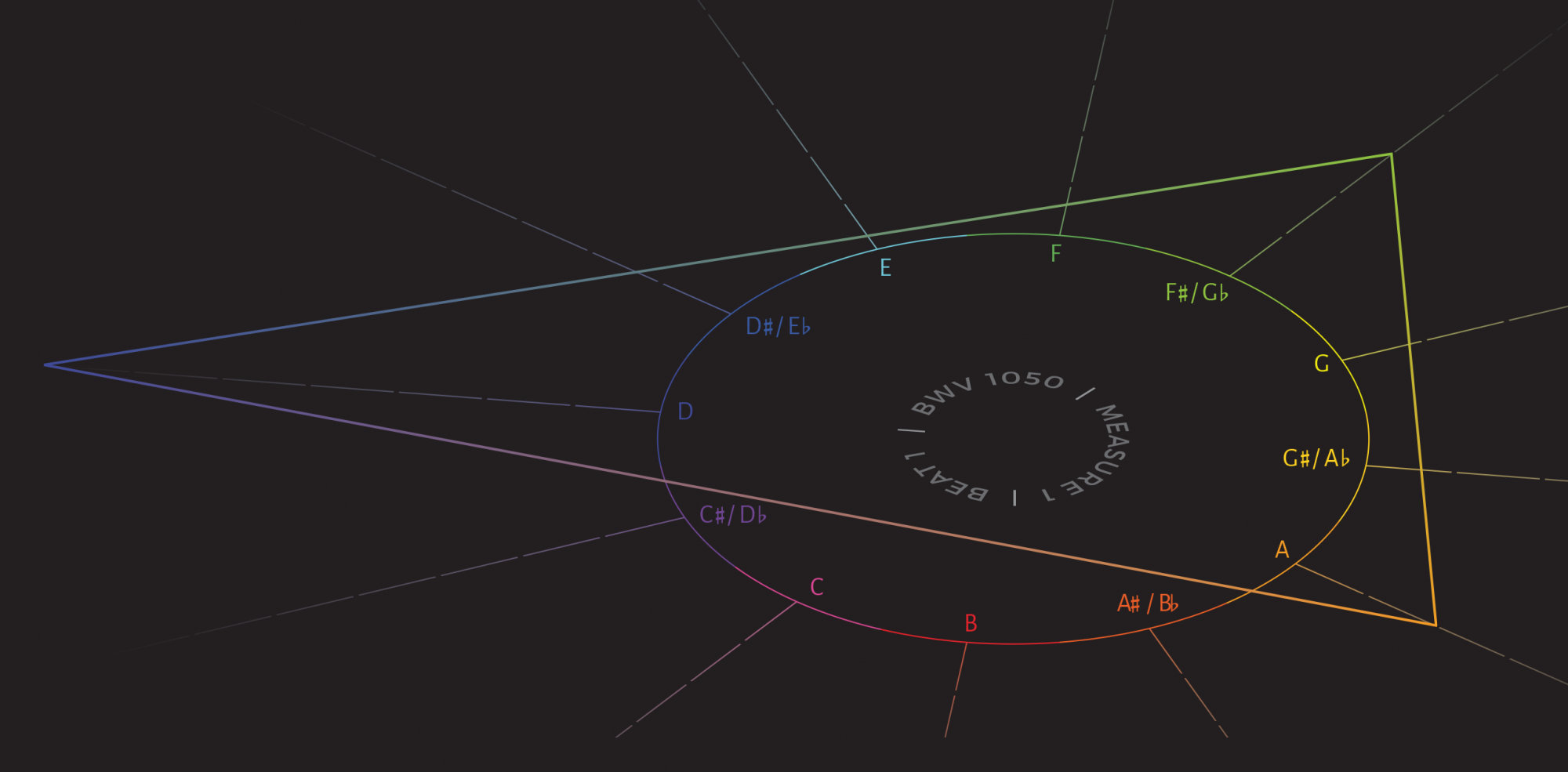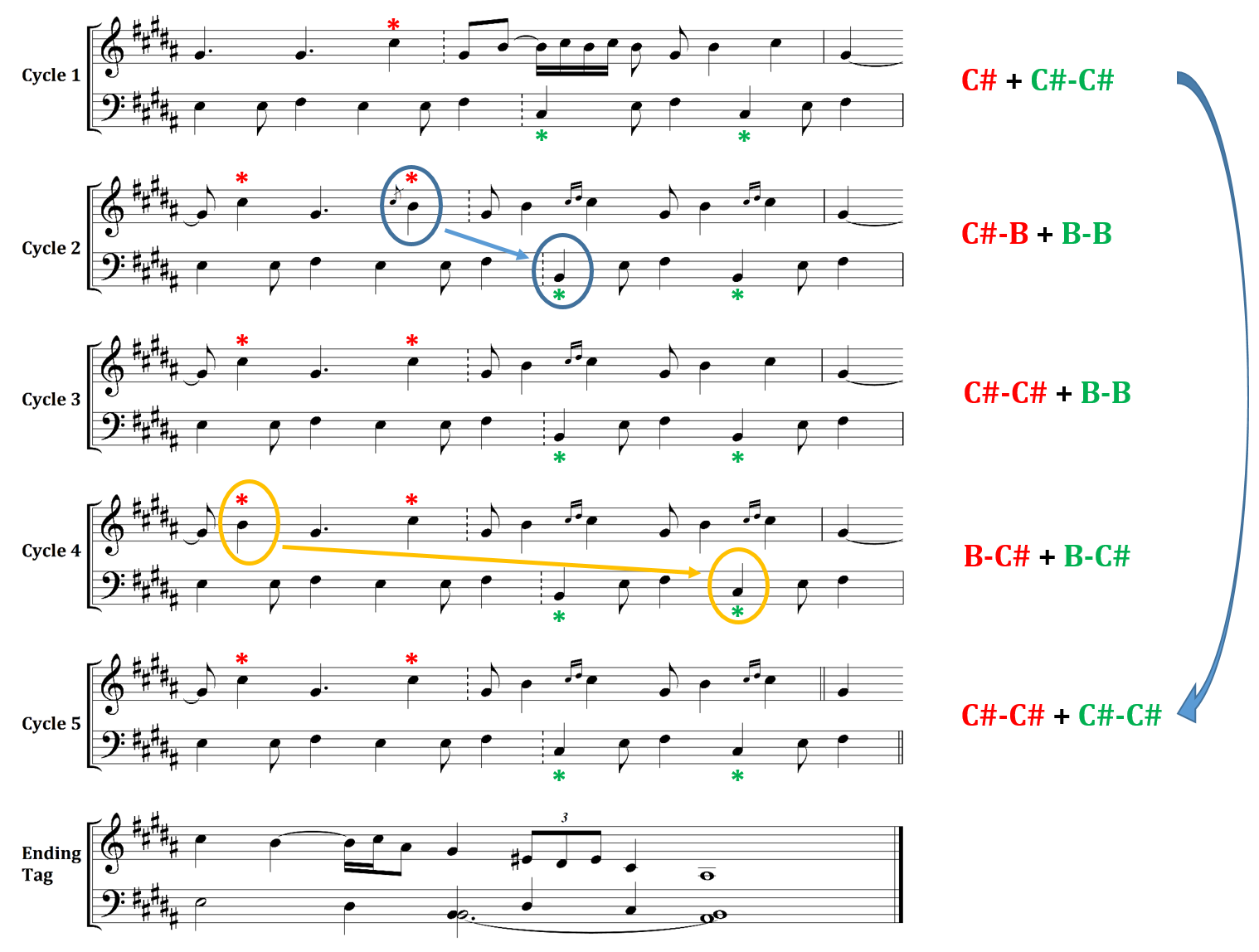Hei-Yeung (John) Lai
Abstract
Many of the sound recordings of the ’Are’are panpipe ensemble music made by Hugo Zemp are characterized by polyphonic and cyclical features. This article analyzes two cyclic pieces from the ’au tahana repertoire in order to articulate the ’Are’are conceptions of musical structure and aesthetics described by Zemp (1979) through the perspectives of counterpoint and formative process. I first scrutinize the counterpoint formed by the two cyclic strata in the selected pieces. Comparing these details with hypothetical models where the cycles are aligned shows that a rhythmic delay between the strata is essential to provide continuity and momentum to the repeating cycles, which also evinces ’Are’are musical aesthetics. I then show that, aside from the contrapuntal driving force, the way that the cycles are actually realized and varied is crucial in directing the processes in ’Are’are music. I suggest that even minimal variations can be instrumental in forging a large-scale form.
Keywords and Phrases: Counterpoint, formative process, cycle, Hugo Zemp, ’Are’are music
Introduction and Broader Context
About half a century ago, ethnomusicologist Hugo Zemp conducted exhaustive research on the ’Are’are people, an indigenous group on Malaita in the Solomon Islands. His research has prompted several studies in recent years on this ethnic group and the significance of the musical instruments they use, mainly through a sociological and anthropological perspective. For example, Michael Webb (2019) wrestles with a larger context of music and dance performance in Melanesia (a subregion of Oceania where Malaita belongs), detailing the islanders’ history and agency of absorbing the music of outsiders into their local repertoires. On the other hand, Hidenori Samoto (2017, 2020) and Seán Linton (2012) have been looking more closely into the ’Are’are people, especially at the materiality that bamboo panpipe music signifies within the culture. The former focuses on the ’Are’are people’s contemporary life, examining the implication of adopting modern audio technology in their music-making (Samoto 2017) and how the practice of assembling bamboo panpipes reflects their mixed socio-cultural life in the present day (Samoto 2020). The latter, in contrast, demonstrates that ecological factors are decisive in shaping the acoustemology of the music of ’Are’are and discusses how their traditional and contemporary music is sustained through local, national, and global contexts (Linton 2012).
Despite the recent growing literature on ’Are’are music, these studies focus mainly on socio-cultural aspects, and theoretical and analytical research on this repertoire is still primarily confined to Zemp’s publications from the 1970s. His studies, for example, document ’Are’are people’s musical concepts, including their classification of musical types and instruments as well as their conceptualization of music theory (Zemp 1978, 1979, and 1981). Among his research output, a vast number of sound recordings offers a rich avenue for further analytical investigations. The two recordings examined in this article are drawn from the CD collection Iles Salomon: ensemble de flûtes de Pan’ aré’aré (Solomon Islands: ’Are’are Panpipe Ensembles), recorded during Zemp’s field trips in the mid-70s (Figure 1). Each recording consists of two iterations of the performance, and the present article only takes the first iteration—referring to Audio Examples 1 and 2 below, respectively—as the subject of analysis.1 Before going into the analyses of the selected pieces, I will first discuss the characteristics and aesthetics of the ’Are’are music illustrated by Zemp to set up a broader context.
Zemp finds that one of the essential characteristics of ’Are’are panpipe ensemble music is its polyphonic texture (1979, 22–31). That is especially well demonstrated in the ’au tahana repertoire, to which the genre of the two musical recordings in question belongs.2 The ’au tahana is considered by the ’Are’are people to be the oldest and the most prestigious panpipe ensemble (Zemp 1978, 48). It consists of four musicians playing a two-part polyphony, each part doubled at the octave. Figure 2a shows two musicians from the ’au tahana ensemble playing panpipes of different sizes that carry out the effect of octave doubling. For clarity, the transcriptions in this article only show the distinct two-part polyphonic layers but not the octave doubling.

In an ’au tahana ensemble setting, the four musicians play in a circle formation, facing inward (Figure 2b). Figure 2c presents a schematic layout of the ensemble arrangement, showing the alternation between small and large panpipes and their combination that forms two distinctive parts. The ’Are’are people call the two parts in the ’au tahana ensemble pau ni ’au and aarita’i, respectively (see the annotations on the two sides of Figure 2c).3 The pau ni ’au refers to the main voice—the “head of the music”—and it is also the layer to be composed and learned first. In contrast, the aarita’i forms the second layer that is “braided” around the pau ni ’au part (Zemp 1979, 22–23). As exemplified by the repertoire discussed in this article, the aarita’i part can be strictly imitative to the pau ni ’au part or feature distinct pitch and rhythmic materials.
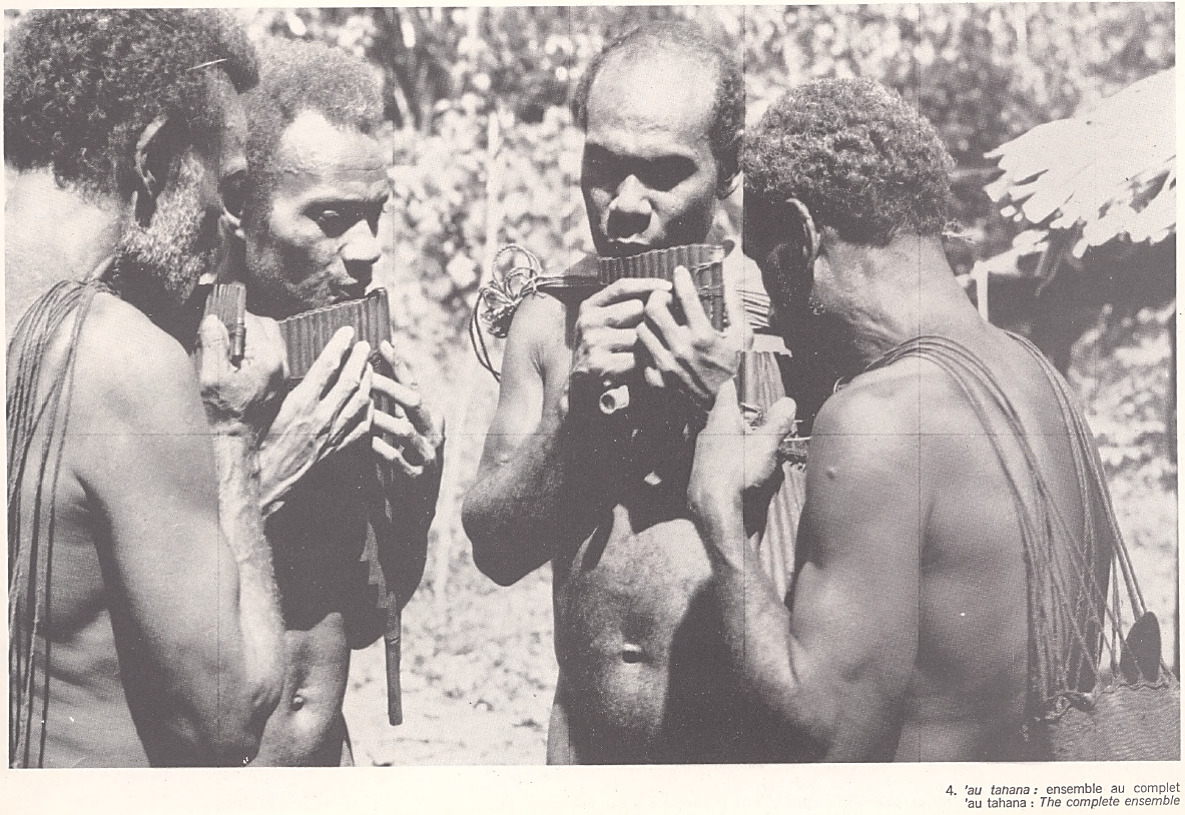
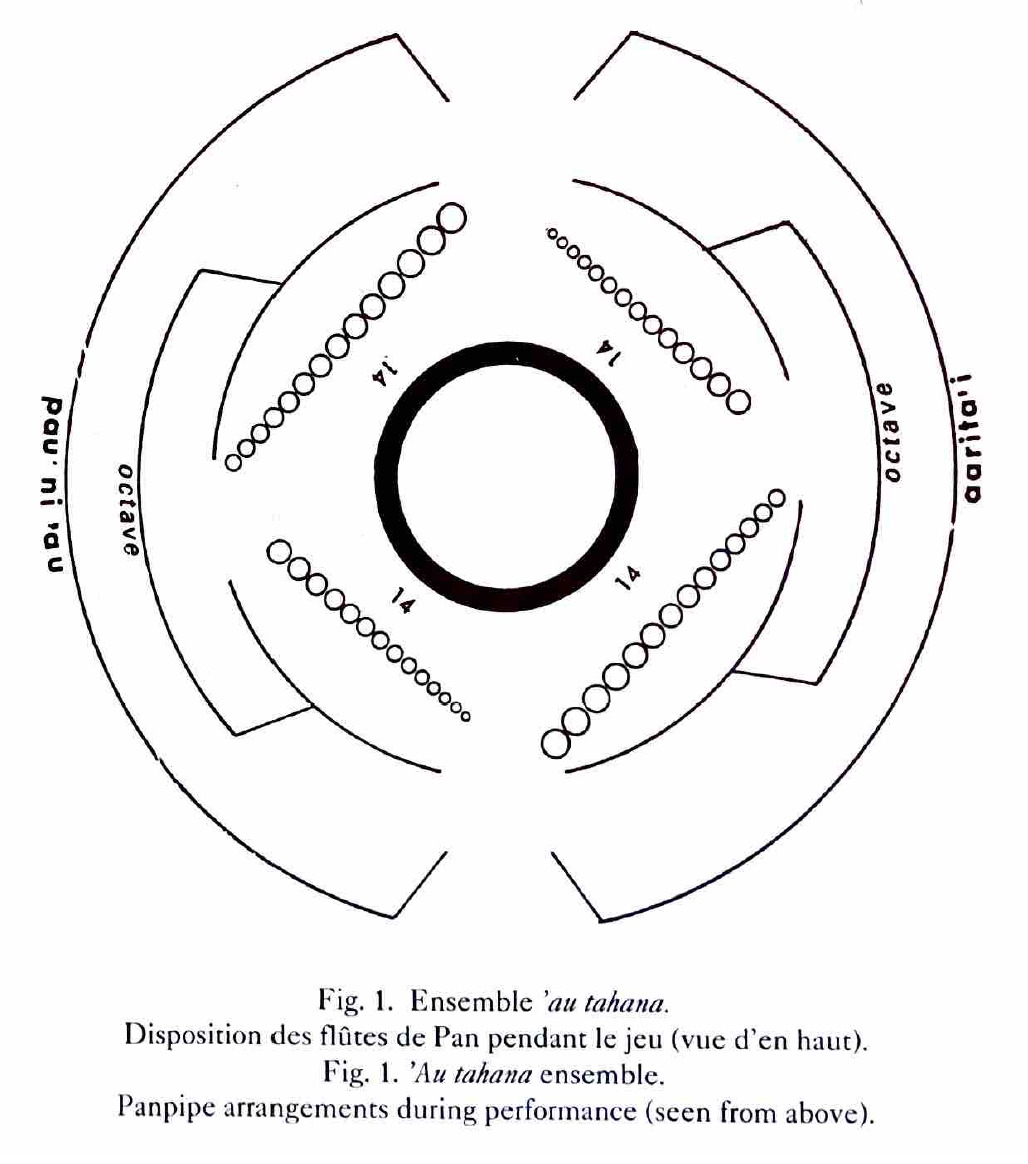
The close, intimate setting of the ’au tahana ensemble may have facilitated musical interactions among the players and accounted for some of the musical aspects documented by Zemp. The ’Are’are people, for example, describe the relationship of the two parts in the music of the ’au tahana ensemble as hikua, which means “to entwine” or “to twist,” suggesting an interlocking musical pattern (Zemp 1979, 22–23). Furthermore, these entwinements result in a voice leading the ’Are’are people call uuhi aara haisuri, where the voices are perceived as a pair of groups that mutually pursue one another.4 According to Zemp, this produces the rhythmic delay characteristic of voices in the ’au tahana texture (29). In other words, the two polyphonic layers do not always align rhythmically. This feature prompted the research questions of my current study: why is a rhythmic delay essential, and how does it contribute to shaping musical structure and process in the ’au tahana repertoire? The openings of Audio Examples 1 and 2 exemplify this intertwining process well, featuring continuous call and response progressions of brief arpeggiated and scalar gestures.
Apart from the interactive voice-leading movement, another musical feature of ’au tahana ensemble music is emphasis on the equiheptaphonic second, which is called rapi ’au by the ’Are’are people (Zemp 1979, 6). The equiheptaphonic second is a step in the equiheptaphonic scale, where the octave is divided equally into seven steps of approximately 171 cents each.5 The equiheptaphonic second is the defining interval of the panpipes used in the ’au tahana ensemble. These panpipes all contain the entire equiheptaphonic scale, and each adjacent pipe forms the equiheptaphonic second. It not only defines the basic panpipe scale but also constitutes a significant element in ’Are’are musical aesthetics as a harmonic interval. The two parts in the ’au tahana ensemble often entwine to create this interval (Zemp 1979; 13, 24). For example, it is used as the final harmonic interval in a large number of pieces of the ’au tahana ensemble (see, for instance, the ending of Audio Examples 1 and 2) (Zemp 1981, 405). As I will demonstrate later, apart from signifying cadential moments, the equiheptaphonic second can also often mark crucial referential moments in the music. Finally, although the following transcriptions are written down in a standard five-line diatonic notation, the actual interval sizes are always in accord with the equiheptaphonic scale.
The final aspect of the ’Are’are music I want to mention before proceeding to the analyses is its cyclicality, where certain pitch and rhythmic patterns immediately and persistently repeat.6 Zemp does not discuss this feature in detail; his transcriptions generally just represent the cyclical repetitions as one iteration with repeat signs.7 Are the repetitions always the same, or do they feature different musical materials, even if the changes are inconspicuous? Moreover, how do ’Are’are musicians create musical variety, closure, and even formal structure under continuous repetitions?
To answer these questions, and to delineate ’Are’are conceptions of musical structure and aesthetics in analytical terms more rigorously than the general descriptions above, the remainder of this article examines two cyclic pieces from the ’au tahana repertoire through the perspectives of counterpoint and formative process. The first approach explores the relationship that the rhythmic delay creates between the two polyphonic layers. In contrast, the second approach focuses on how the cycles are actually realized and varied and how those variations, even though they might seem to be insignificant, can create large-scale processes.
1. Counterpoint
The first part of the analysis scrutinizes the contrapuntal details formed by the two cyclic strata in selected ’Are’are music, specifically, vertical intervallic content, melodic contour, and composite rhythm. This approach draws inspiration from Gretchen Horlacher’s (1992) method for analyzing the intervallic structure of Stravinsky’s ostinati where the vertical possibilities highlight certain key pitches and sonorities in the course of the cyclic process and ultimately inform the formal development. I am not suggesting that ’Are’are musical style is connected to Stravinsky’s ostinato practice. Rather, I aim to show by this approach how ’au tahana counterpoint provides continuity and momentum to repeating cycles and exemplifies some ’Are’are musical features—for instance, a directionality that leads towards and highlights the significant equiheptaphonic second initiated by the rhythmic delay.
The first example is drawn from the piece Roromera Keni ni mato.8 Example 1 shows a transcription made by Zemp (1979, 30) with my annotations shown in color: numbers, circles, arrows, and shaded regions (the complete recording can be found in Audio Example 1). The entire melody of Roromera repeats every twenty-four quarter notes. Yet, its internal grouping is also very cyclical in nature; the long-repeating melody can be grouped into four similar melodic segments, each six quarter notes long, delineated by the dotted bar lines added by Zemp. For example, considering the part in the lower staff, the first and the second segments are the same, whereas the notated C5 in the first two segments is then changed to a notated G4 in the third and fourth segments. Looking into the pitches and intervals used more closely, the melody uses six pitches only (notated here as C4, E4, F4, G4, A4, and C5) that form a pentatonic collection. In addition, it emphasizes thirds as melodic intervals, most prominently found and audible in 1) the notated <C4–E4> ascent in the lowest register (that occasionally goes further to the notated G4) and 2) the downward notated <C5–A4–F4> arpeggiation in the highest register.

While the horizontal aspect of each part features repetitive internal groupings, the vertical relationship between the two parts also suggests a source of repetition, which refers to a strict imitative texture. The upper part plays the (almost) same melody as the lower part but with a rhythmic displacement of nine quarter notes.10 The two blue asterisks in Example 1 indicate the beginning of the melody in the lower part and the corresponding position in the displaced upper part, respectively. The annotation between the staves shows that this canonic technique results in rich successions of harmonic intervals. They involve combinations of specific pitches, notated as E4–F4 (equiheptaphonic second), C4–E4 (equiheptaphonic third), C4–G4 (equiheptaphonic fifth), C4–A4 (equiheptaphonic sixth), and C4–C5 (octave). Obviously, an imitative texture needs to have a rhythmic delay because otherwise, the two parts would sound exactly together and indistinguishable (that is, the intervallic succession between the two parts would be in unison). So the more important question is why this particular rhythmic delay was chosen.
One feature of this arrangement is that the resultant composite melody makes the emergence of different groupings of salient musical events possible, and the repeating, cyclical hearing helps one pick out and appreciate these varieties fully. For example, those who focus on the composite rhythm could hear a continuous short-long (S-L) pattern associated with a specific pitch progression. The short note always falls on a notated C4, while the different pitches the long note plays outline a C-major triad—namely, the notated E4, G4, or C5. On the other hand, different registrally partitioned layers might stand out when one hears the composite melody. For instance, the notated lowest <C4–E4> progression can form a layer, repeating every three quarter notes. The downward notated <C5–A4–F4> arpeggiation that floats over the top could be heard as another layer, even though it does not repeat in a strictly consistent manner. Taking the downward arpeggiation in the first segment of the lower part as a reference point, the inter-onset interval between each adjacent arpeggiation’s beginnings (that is, the notated C5) are six, three, six, and nine quarter notes apart, respectively. Finally, those who pay attention to the descending gestures leading toward the notated F4 (shaded in yellow in Example 1)—the downward notated <C5–A4–F4> arpeggiation and the stepwise notated <G4–F4> descent—could hear another regular layer, where the two gestures alternate continuously every three quarter notes. Regardless of which groupings or layers one attends, the rhythmic delay and the resultant composite melody facilitate another facet of regularity different from that of the cyclical internal grouping featured in the individual part.11
The last-mentioned stratified layer—a hearing that focuses on the motion leading toward the notated F4—deserves further attention. Although one might argue that this middle layer might be less audible than other strands located at the registral extremes, it highlights a specific feature that other strands or groupings do not. That is, the notated F4 is always harmonized by the notated E4 in another part, forming a harmonic interval of an equiheptaphonic second (circled in red in Example 1). The occurrence of this interval is always emphasized by durational accents, contrary motion (represented by the upward and downward green arrows in Example 1), and simultaneous attacks of the two parts. The only other simultaneous attacks of the two parts in this piece—the equiheptaphonic sixth (notated C4–A4)—is heard more like a short anacrusis (notated C4) or continuation (notated A4) that leads toward the long notated E4–F4 equiheptaphonic second. The regular recurrence of the equiheptaphonic second gives the music a sense of stability, especially because of its inherent quality of signifying an ending function in the ’au tahana repertoire. Zemp (1981, 405) has documented that the ’au tahana repertoire always ends on an equiheptaphonic second (see, for example, the ending of Roromera (notated C4–B3) and the ending of Paane ni Rokera [notated A$$\sharp$$2–B2 in Example 5]).12 Here, I hear the equiheptaphonic second’s ending function more generally and locally. That is, apart from the ultimate ending, this harmonic interval could function similarly to mark the closure of a melodic segment.13
The second example is drawn from the piece Paane ni Rokera (the complete recording can be found in Audio Example 2), which is also primarily pentatonic (notated E, F$$\sharp$$, G$$\sharp$$, B, and C$$\sharp$$).14 Example 2 presents the opening of Paane.15 Unlike the imitative texture of Roromera, the two registrally partitioned strata in Paane function as independent cycles, playing distinct pitch and rhythmic patterns. The lower part plays a continuous L-S-L rhythmic pattern with a recurring pitch pattern. The first long note is either a notated E3 (in the first half of the cycle) or notated B2/C$$\sharp$$3 (in the second half of the cycle). In contrast, the following S-L pattern always associates with the notated pitches E3–F$$\sharp$$3. On the other hand, the upper part (after cycle 2) features richer rhythmic varieties, repeating a pattern of L-L, L-L, S-L-L, and then S-L-L. In the L-L pattern, the first long note is always a notated G$$\sharp$$4, followed by either a notated B4 or C$$\sharp$$5. Meanwhile, the S-L-L pattern always associates with the notated pitches <G$$\sharp$$4–B4–C$$\sharp$$5>. Note that when the lower part plays a notated <C$$\sharp$$3–E3–F$$\sharp$$3> gesture in the second half of the cycle, it strengthens the interaction with the upper part, since it is a (pitch-class) transposition up two pentatonic steps of the upper part’s <G$$\sharp$$4–B4–C$$\sharp$$5> gesture.16
Looking into Example 2 more closely, one might notice that the upper part in the first cycle, which serves an introductory function, is slightly different from the following cycles. Instead of beginning with the recurring twenty-eighth-note-long cycle right away, the first half of the upper part’s introductory cycle is shorter. The supposed two-eighth-note-long second note (notated C$$\sharp$$5) is missing in the first cycle (indicated by the red parenthesis in Example 2), creating a rhythmic delay that makes the cyclic boundaries of the two parts not in sync. In this case, what is the purpose of having a rhythmic delay? Taking the second cycle as a reference (shown at the bottom of Example 3), I construct hypothetical models where the cycle boundaries are in sync (top staves of Example 3) or are displaced by another durational value (middle staves of Example 3) correspondingly. Comparing the different contrapuntal details in these two-part counterpoints (hypothetical or actual) reveals the significance of rhythmic delay in this piece.

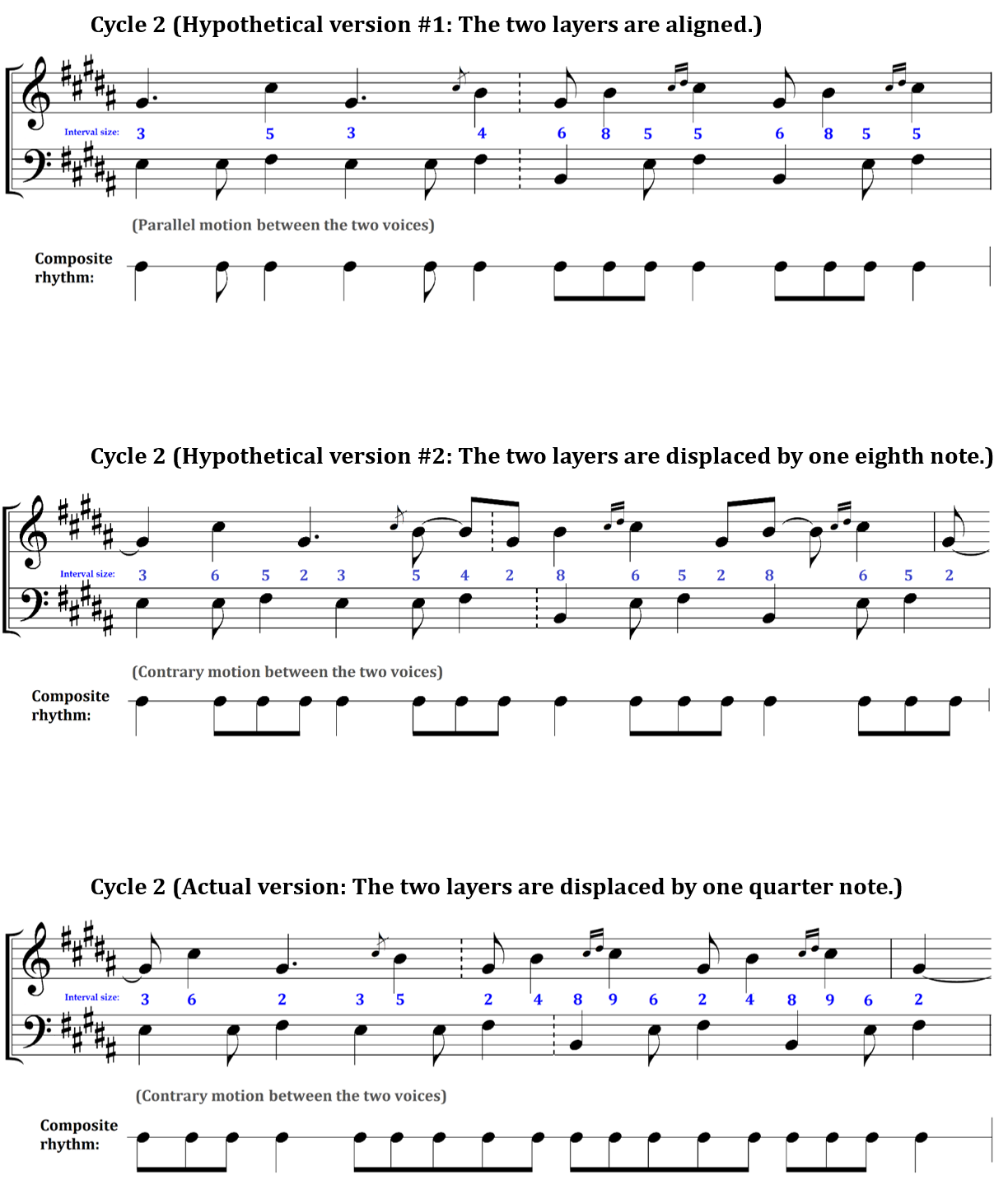
Considering the resultant vertical sonorities and the composite rhythm, the actual rhythmic delay between the layers generates richer harmonic variety, contrary motion between the two parts, and denser rhythmic activity than the alternatives. Specifically, in the first hypothetical version, where the cyclic boundaries of the two parts are in sync, no equiheptaphonic second is formed vertically. Such a characteristic harmonic interval is present when the two parts are displaced by one eighth note (hypothetical version #2), but its occurrences are fleeting and hardly emphasized. The equiheptaphonic seconds are not a result of simultaneous attacks of the two parts but appear only as an intervallic byproduct during the interlocking motion. Also, they lead toward a simultaneous attack of an octave interval that takes a durational accent (in the second half of the cycle). The octave emphasis might sound too hollow and disturb the continuous flow of the cyclic movement.
In contrast, when the two layers are displaced by a quarter note as in the actual realization, a string of continuous composite eighth-note attacks directs the musical movement toward an equiheptaphonic second, further reinforced by the sparse yet prominent durational accents. These equiheptaphonic seconds (those that receive a durational accent as well as those situated in the middle of the cycle) also highlight the only moments where the two parts attack a note at the same time. One can check the distinct sonic qualities of these different cyclic realizations in Audio Examples 3a–c.18
2. Formative Process
Having illustrated the contrapuntal details in the two selected ’au tahana pieces, I now examine their formative process characteristics. Apart from the momentum that the two-part cyclic counterpoint creates, a crucial element in directing the musical process is the way in which the cycles are actually realized and varied, as well as consequent interactions between the two parts. John Roeder (2019) demonstrates that the musical practice of variation is also present in cyclic duets from other traditional cultures, such as another repertoire of the ’Are’are people, the Jivaro from eastern Ecuador, and the Wayapi people in French Guyana. The two voices in the cyclic duets can be regarded as independent and equally significant. From the perspectives of timbre, timing, and grouping structure, Roeder posits that the cyclic variations can be heard as the products of deliberate control by the performers. By coordinating their variations, the two-voice interaction can direct the cyclic repetitions, give a sense of closure, and even forge large-scale musical forms (3–4). Here, I take a similar stance to examine the cyclic variations in the two examples of ’au tahana music. Although the variations, which occur primarily in pitch, seem minimal, they still shape the musical form.
Before proceeding to the analyses, however, it is important for me to address the implications of my analytical interpretations. Given the enormous repertoires Zemp was dealing with in his ethnographic studies, his transcriptions usually only capture the general framework of the music and may have overlooked the specific variations carried out by the performers. This gap is exactly the point of departure where I see the analytical potential of examining these details of the performances. Yet, as a music theorist without conducting any ethnographic work and only accessing the music through digitalized recordings, I find myself not in an appropriate position to assert any further aesthetic and performance issue other than my analytical observations. Without any emic knowledge, it is unclear whether the seemingly planned musical processes illustrated below, not identified by Zemp, might be meaningful to, or are conceptualized by, ’Are’are musicians. Also, it is uncertain whether the performers would play the variations exactly the same on other occasions when they play the pieces again. My analysis only takes Zemp’s recordings into consideration and analyzes the recording as is. Even in the recordings alone, the variations found within the two iterations of the performances are not entirely the same (again, I consider the first iteration only in this analysis, and differences found in the second iteration of each piece are described in footnotes 20 and 21, respectively). In other words, the particular musical processes described below might be heard for that one specific performance only, and one could not generalize them as an inherent aesthetic without further emic knowledge.19 Nevertheless, these musical details call my ear to attention and invite further analytical interpretations that offer another way to appreciate the music of ’Are’are.
Example 4 modifies and rearranges Zemp’s transcription of Roromera to show the complete repetitions. Each system represents one iteration of the musical cycle, which is repeated three times. In this performance, the lower part seems to be taking the lead, initiating musical cues that call for the upper part’s responses. The variations always begin at the mid-point of the cycle. This position is structurally salient because it is the only moment that the notated descending arpeggiated <C5–A4–F4> gesture is juxtaposed immediately between the two parts. The first cycle does not involve any variation, and the music matches Zemp’s transcription entirely.
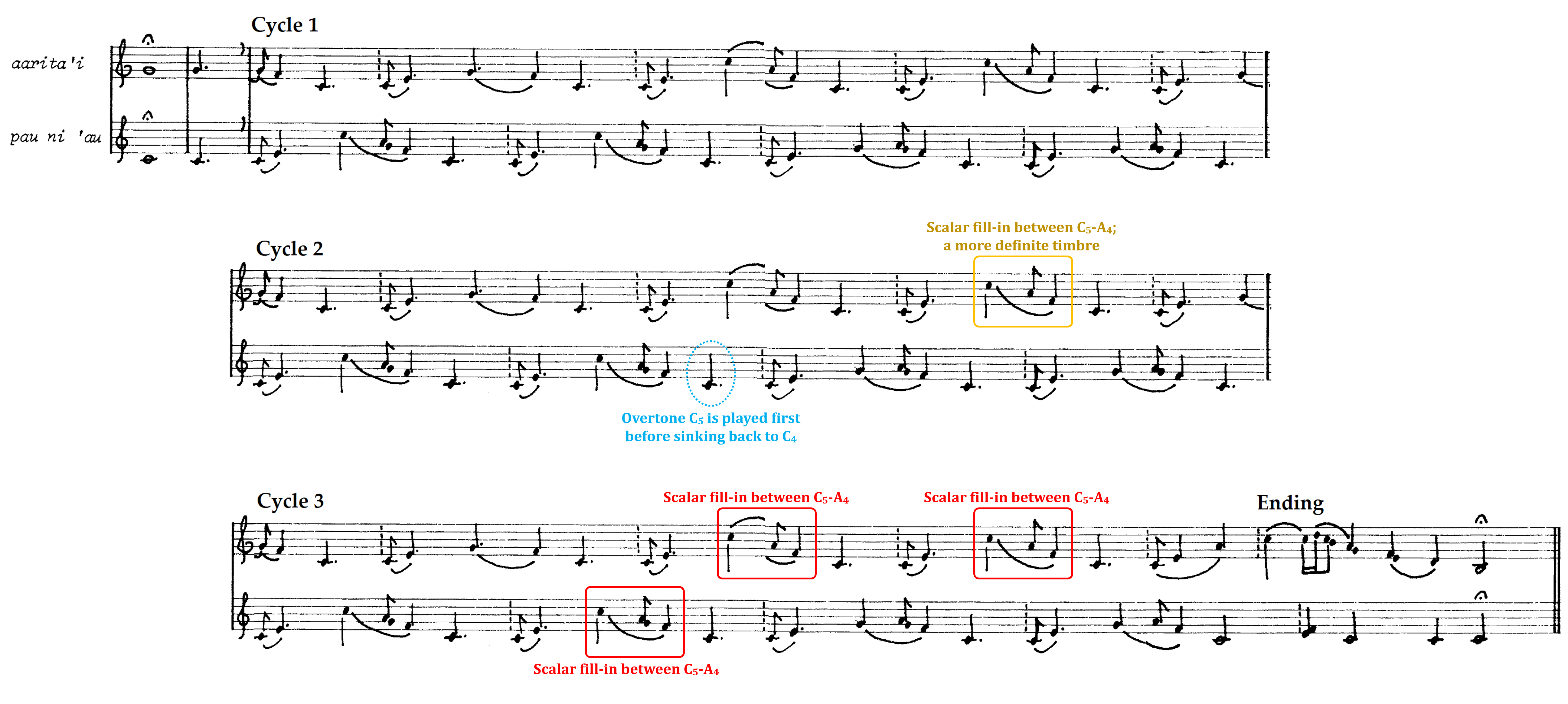
The second cycle, however, starts varying slightly. After the second notated descending arpeggiated <C5–A4–F4> gesture, the lower part overblows a bit. Instead of playing the notated C4 right after, it sounds an overtone C5 momentarily before sinking back to the lower octave (circled in blue). Perhaps hearing the overblow as intentional, the upper part player may have wanted to respond to it. Yet, there might not be enough time for him to react if he wants to create variation immediately in the following arpeggiated gesture. So, instead, he modifies the next gesture (boxed in yellow) by filling in the first two notes of the notated descending gesture <C5–A4> with a passing motion. Also, this particular gesture is played with a more definite timbre.
Perhaps inspired by the upper part’s scalar-fill-in gesture in the previous cycle, the lower part adopts the same modified figure in the third cycle (boxed in red). This time, the upper part has sufficient time to prepare the response and fill in the arpeggiation. Hence, two consecutive repetitions of the filled-in arpeggiated gesture appear at the mid-point of the third cycle. It is also after this modified structural moment that the music begins to slow down, signaling the closure of the piece. After that, the upper part plays the scalar-fill-in gesture one last time, leading to the cycle’s break and the ending segment.20
The next example, Paane, illustrates an even more elaborate variation of pitch, resulting in a departure-return-like process (Example 5). In this example, it is the upper part’s variation that calls for a response from the lower part. After introducing the shortened top voice in Cycle 1 (demonstrated in Example 2), the pitch and the rhythmic sequences of the two parts in the remaining cycles stay the same, except for those pitches that lie in the registral extremes. These pitches involve alteration between the notated C$$\sharp$$ and B in the upper part’s high register and the lower part’s low register. The red and the green asterisks in Example 5 indicate these notes in different parts, respectively. These registral extremes play the same notated C$$\sharp$$ in the first cycle. The upper part, however, initiates a change in the second cycle—the second restatement of the high pitch is altered from the notated C$$\sharp$$5 to B4 (circled in blue). This alteration seemingly calls for a response from the lower part, where it responds by changing the two registral low notes to the notated B2 (indicated by the blue arrow and circle).
In the following cycles, the notated C$$\sharp$$5 always serves as the referential registral high point in the upper part. In contrast, the registral low point in the bass always follows the last nadir played in the previous cycle. As a result, in Cycle 3, the upper part returns to two statements of the notated C$$\sharp$$5, whereas the notated B2 remains in the lower part. The next cycle involves another pitch alteration from the notated C$$\sharp$$5 to B4 in the upper part again (circled in yellow). Similarly, perhaps noticing the cue, the bass responds by changing the second restatement of the low pitch from the notated B2 to C$$\sharp$$3 (indicated by the yellow arrow and circle).
The pitch alterations brought from the previous cycles lead to a union of the same notated note C$$\sharp$$ again in Cycle 5 between the two parts. Overall, the combinations of these registral focal pitches are always different (see the annotations on the right of Example 5), providing a fresh, renewing experience to each cyclic repetition. Moreover, these cyclic variations suggest a large-scale formal process. The opening C$$\sharp$$ pair implies a starting point, from which the music evolves through different pitch alterations and combinations between the notated notes C$$\sharp$$ and B, to finally achieve a reunion of the pitch class in the last cycle. Recognizing the variations of these registral focal pitches across the cycles illuminates further the introductory function of the first cycle retrospectively. Instead of starting with the notated S-L-L <G$$\sharp$$4–B4–C$$\sharp$$5 (ornamented with D$$\sharp$$5)> pattern at the second half of the cycle, which recurs consistently in the following cycles, the upper part articulates a notated sixteenth-note <B4–C$$\sharp$$5> alternation in the first cycle. This uniquely different pitch and rhythmic gesture may then be understood as foreshadowing the two parts’ interactive play between those two notes in the following cycles.21
Conclusion
In sum, this article elucidates ’Are’are conceptions of musical structure and aesthetics, identified by Zemp, by analyzing two cyclic pieces from the ’au tahana repertoire through the perspectives of counterpoint and formative process. Whether the two cyclic strata are imitative in texture or function as independent cycles, in either case, a rhythmic delay between them generates richer harmonic varieties and denser rhythmic activities. The resultant interlocking patterns, contrary motion, and harmonic emphasis of the equiheptaphonic second all evince ’Are’are musical aesthetics. I have also demonstrated that cyclic variations, even though the changes might be minimal, are perceptible and instrumental in directing musical process in the two selected ’au tahana pieces. A possible future research direction will be continuing to use Zemp’s ethnographic recordings, examine the musical details, and see how those variations, which might be different in each individual performance, could inform one’s listening experience and perception of the musical process.
References
Horlacher, Gretchen. 2000/2001. “Multiple Meters and Metrical Processes in the Music of Steve Reich.” Intégral 14/15: 265–297.
———. 1992. “The Rhythms of Reiteration: Formal Development in Stravinsky’s Ostinati.” Music Theory Spectrum 14 (2): 171–187.
Linton, Seán J. 2012. “The Music of ’Are’are: Acoustemology, Environmental Influences and Sustainability.” PhD diss., Otago University.
McKinnon, James W., Robert Anderson, John M. Schechter, Mervyn McLean, Tiberiu Alexandru, Grigol Chkhikvadze, and Alan R. Thrasher. 2001. “Panpipes.” Grove Music Online. Accessed 30 November 2022.
Roeder, John. 2019. “Timely Negotiations: Formative Interactions in Cyclic Duets.” Analytical Approaches to World Music Journal 7 (1). https://aawmjournal.com/articles/2019a/Roeder_AAWM_Vol_7_1.html.
———. 2003. “Beat-Class Modulation in Steve Reich’s Music.” Music Theory Spectrum 25 (2): 275–304.
Samoto, Hidenori. 2020. “Assembling Bamboo Panpipes in the Blended Life: Musical Mediation in a Village of ’Are’are, Solomon Islands.” People and Culture in Oceania 36: 1–26.
———. 2017. “Unstable pitch in the rainforest and the mimesis of music: The articulation of audio technology and musical techniques in the bamboo panpipes of ’Are’are, Solomon Islands.” Shima: The International Journal of Research into Island Cultures 11 (2): 151–167.
Smith, Sandra. 1984. “Panpipes for Power, Panpipes for Play: The Social Management of Cultural Expression in Kuna Society.” PhD diss., University of California, Berkeley.
Tenzer, Michael. 2017. “Transforming African Musical Cycles.” Music Theory Spectrum 39 (2): 139–157.
Webb, Michael. 2019. “Melanesian Worlds of Music and Dance.” In The Melanesian World, edited by Eric Hirsch and Will Rollason, 455–470. London: Routledge.
Zemp, Hugo. 1994. Liner notes for Iles Salomon: ensemble de flûtes de Pan ‘aré’aré. Translated by Peter Crowe. Le Chant du Monde LDX-274-961.62, 2 compact discs.
———. 1981. “Melanesian Solo Polyphonic Panpipe Music.” Ethnomusicology 25 (3): 383–418.
———. 1979. “Aspects of ’Are’are Musical Theory.” Ethnomusicology 23 (1): 5–48.
———. 1978. “’Are’are Classification of Musical Types and Instruments.” Ethnomusicology 22 (1): 37–67.
———. 1971. Liner notes for Flutes De Pan Mélanésiennes – Malaita – Solomon Islands – Vol. 1. Recorded 1969. Translated by R. Mason. Disques Vogue LDM-30-104, 2 compact discs.
Sound Recordings
“Paane ni Rokera.” Performed by Kinipa’ea, Ooreana, ’Irisipau, and Warahane. Recorded 10 February 1975 by Hugo Zemp at Raroasi, Malaita in the Solomon Islands. From Iles Salomon: ensemble de flûtes de Pan ‘aré’aré (Track 2). https://archives.crem-cnrs.fr/archives/items/CNRSMH_E_1994_001_001_001_02/.
“Roromera Keni ni mato.” Performed by Kinipa’ea, Ooreana, ’Irisipau, and Warahane. Recorded 10 February 1975 by Hugo Zemp at Raroasi, Malaita in the Solomon Islands. From Iles Salomon: ensemble de flûtes de Pan ‘aré’aré (Track 6). https://archives.crem-cnrs.fr/archives/items/CNRSMH_E_1994_001_001_001_06/.
Notes
- Readers who want to compare the second iteration of the performance can consult the complete recording digitalized in the Center for Research in Ethnomusicology (CREM) website. See References below.
- Apart from discussing the polyphonic texture demonstrated in the ’au tahana ensemble, Zemp (1979) also explores those exhibited in the ’au paina ensemble, the ’au keto ensemble, and the ’au taka’iori ensemble, which feature two-part, three-part, and four-part polyphony, respectively.
- The ensemble setting captured in Figure 2b fits the schematic layout shown in Figure 2c, although it is unclear which pair belongs to the pau ni ’au (or aarita’i). The two people on the left of Figure 2b belong to one part (where the one facing front plays the bigger panpipes), both playing toward the middle-left part of the panpipes (i.e., the side with the longer tubes). In contrast, the pair on the right side belongs to another part (where the one facing front plays the smaller panpipes), both playing toward the right side of the panpipes (i.e., the side with the shorter tubes).
- Such an intertwining relationship between two musical parts is also evident in panpipe music of other traditional cultures. For example, the gendered paired (male–female) panpipe music in the gammu burui repertoire of the Kuna people features an interlocking texture and the equiheptaphonic scale (Smith 1984, 167–177). Similarly, in Andean siku music, one instrument is referred to as the leader (ira) and another the follower (arca) (both also structured in a gendered pair) (McKinnon et al. 2001). Although these repertoires differ in many significant ways, to what extent the transpacific connection contributes to the development of panpipe music in these places could be a subject for further research.
- Each tube of the ensemble instruments is measured with a stick (or a string) and is crafted manually, and the tuning is constantly corrected by ear. According to Zemp (1981, 392–393), among the four instruments of an ’au tahana ensemble, 50% of the intervals deviate not more than 5 cents from the equiheptaphonic interval of 171 cents, and 88% of them deviate less than twenty cents.
- For a fuller definition of cycle and a discussion of the implication of cyclical hearing, see Roeder 2019, 3–4.
- Zemp does not use the terms “cyclic” or “cyclicality” to describe this formal feature. Instead, he refers to an ’Are’are conception called ro’u mani ’au, which he translates as “melodic segment,” to explain the structure of their pieces (Zemp 1979, 13–16; 1994, 66–67). This conception usually delineates movements of musical gestures and the joining of musical units but does not convey any sense of repetitiveness. Nevertheless, Zemp identifies that ’Are’are pieces are typically built upon numerous repetitions of melodic segments. Putting this phenomenon into the analytical term I use here, a cycle can either be formed solely by one melodic segment or constitute several melodic segments, to which that cycle is subject to immediate and persistent repetitions.
- The title of this piece refers to a lullaby called “The woman of the earth”—a lullaby that is very well known to the ’Are’are people (Zemp 1994, 71). Zemp, however, did not provide the text for this lullaby. Otherwise, further analysis of the simultaneities between the syntactic units of the text and the shape of the melodic units could possibly enrich one’s understanding of the piece.
- Zemp’s transcription of Roromera transposes the heard pitches to a key with no accidentals. So, for example, the opening notated fifth C4–G4 actually sounds approximately like an equiheptaphonic fifth C$$\sharp$$4–G$$\sharp$$4 in the recording.
- The only minimal differences between the two parts are 1) the occasional insertion of a neighbor note in the third and fourth segments (notated G4–A4–F4 in the lower part versus G4–F4 in the upper part) and 2) the fleeting notated G4 (within the notated C5–A4–F4 gesture) in the first and second segments in the lower part.
- The outcome of listening to repeating patterns, which enhances the possibility of hearing different dimensions of the pattern, reminds one of the aural effects that pattern-repetition minimalist music features, such as those exhibited in Steve Reich’s phasing music. For example, Gretchen Horlacher (2000/2001) suggests that as the patterns shift over time, different alignments of the repeating patterns (in Piano Phase and The Desert Music) can induce various metrical cues (in Horlacher’s term, “multiple meters”), depending on which register, duration, or gesture (hence, which grouping) listeners attend to. Horlacher argues that it is precisely the repetitiveness that allows listeners to discover and embrace all these possibilities. Using Reich’s more recent repertoire to discuss a similar phenomenon, John Roeder (2003), enlarging beat-class set theory, illustrates how one’s orientation of the “downbeat” (or in Roeder’s term, the “beat-class tonic”) can shift during the additive process of other repeating layers. However, it should be noted that Reich’s phasing music and the piece studied here are essentially different. The change of alignment of the patterns largely prompts the shifting orientation in Reich’s music. In contrast, the distance between the two layers in Roromera is always fixed. Yet, it still brings out a rich possibility of pattern groupings, which a repeating, cyclical hearing would benefit from. I thank an anonymous reviewer for pointing out this aural resemblance.
- The endings of the two pieces analyzed here also adhere to other cadential formulas featured in the ’au tahana repertoire. For example, they include a descending melodic movement, a “break shifting” (known as mou ’isu; that is, alternation between tones before settling on the final tone), and a long-held final tone (Zemp 1979, 19–21).
- Apart from the ending function signified by the equiheptaphonic second, specifically in the context of the ’au tahana repertoire, I could imagine hearing the notated F4 as a melodic goal functionally with my “Western classically trained ears,” further strengthening its ending character. That is, the two descending gestures can be heard as either a $$\hat{5}$$–$$\hat{1}$$ (C5–F4) or $$\hat{2}$$–$$\hat{1}$$ (G4–F4) progression, respectively. Yet, this hearing might not be suitable in the current context because 1) of the equiheptaphonic tuning and 2) it is not clear which note the ’Are’are people conceive as “tonic” in this context. Is it the notated F? Or is it the notated C, which appears in two octaves and begins the performance with its upper fifth?
- The piece was composed and named after the sounds of spring in Rokera (Zemp 1994, 71).
- Following Zemp’s transcription, the dotted bar lines in my transcription denote segmentation of melodic groups. In contrast, the solid bar lines (not used in Zemp’s) indicate the boundaries of different cyclic iterations.
- Some cyclic music of other traditional cultures also features a similar transpositional connection between musical segments that provides continuity within the cycle. For example, Michael Tenzer (2017) illustrates how the pitch structure of two contrasting African cyclical musics (Nhemamusasa from Zimbabwe and Hindehu from the Central African Republic) is generated by continuous transpositions of small musical cells.
- My transcription of Paane, in contrast to Zemp’s approach, reflects the actual sound heard in the recording (excluding the tuning factor), which accounts for the key signature I am using here.
- These soundtracks are generated in twelve-tone equal temperament and not in the equiheptaphonic scale, so the timbral qualities will be different from those in Audio Examples 1 and 2.
- Linton’s (2012) methodological approach might be instructive for further research on the general practice of variation the performers take during performance. Lindon examines the acoustemology of the music of ’Are’are through the lens of ecology, demonstrating, for example, the relationship between instrument construction, the sound and function of the music, and environmental influences. On the other hand, although Zemp did not detail the compositional process, he also mentioned that most ’Are’are pieces “are composed as if ‘reflection’ of environmental sounds” (1994, 63). Taking the cues illustrated by Linton and Zemp, other than the materiality of the instrument and the general inspiration for compositions, (in what way) is the musical detail in the performance of ’Are’are people—especially variation technique—also related to their surrounding ecosystems and environments?
- In the second iteration of Roromera in the recording, the lower part does not overblow in the middle of the second cycle (corresponding to the moment circled in blue in Example 4). Yet, the scalar-fill-in gesture begins to emerge at that same moment in the upper part, probably suggesting the formal significance of that moment (that is, the midpoint of the entire performance).
- The second iteration of Paane in the recording shares a similar kind of pitch substitution and formative process only partially. After the same introductory cycle, one cycle is truncated in the second iteration. The registral high point of the upper part always stays on the notated C$$\sharp$$5 without changing to the pitch B4. In contrast, the alternating trajectory of the registral low point of the lower part remains the same, switching from the notated C$$\sharp$$3 to B2 and back to C$$\sharp$$3.
